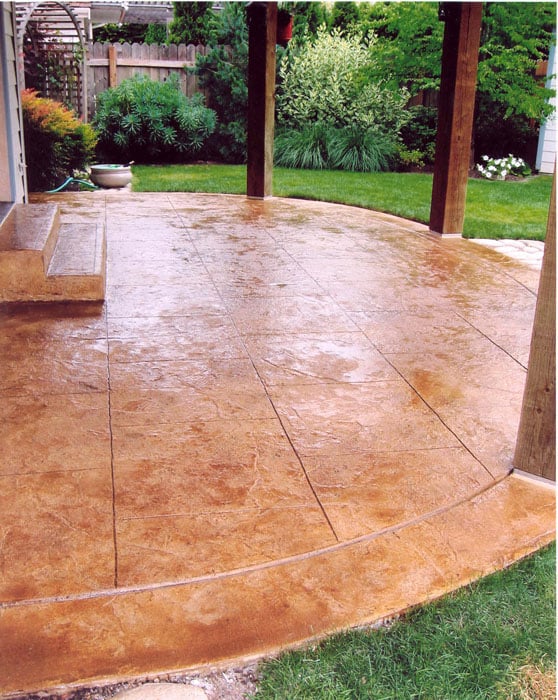 Slip Resistant Stamped Concrete Patio
Slip Resistant Stamped Concrete PatioStamped concrete is wonderful flooring option that recreates the look of natural stone, tile, wood, or brick. This type of concrete is ideal for both indoor and outdoor surfaces, and it is available in a wide variety of colors. While many assume that stamped concrete is slippery, it is not usually the concrete itself that is the problem – it is the sealer.
What Makes Concrete Slippery?
Concrete is a porous material, so to prevent it from absorbing liquids, spills and stains you should seal it after it has cured. Outdoor concrete surfaces are typically sealed using clear acrylic, which helps to not only enhance the color of the concrete, but repel water as well. Learn more about sealing concrete.
This sealer dries clear, creating a plastic-like film over the concrete itself. Because the sealer is water-resistant, water tends to pool on the surface, which can create slippery conditions. This problem is especially common when the sealer has been applied in a layer that is too thick. Fortunately, there are several ways to make stamped concrete slip-resistant.
At SUNDEK of Washington, we install stamped concrete overlays and make sure they are sealed without being slippery.
Free Analysis & EstimateSlip-Resistant Stamped Concrete
One method for making stamped concrete less slippery involves using a certain tool to finish the slab. Rather than finishing the concrete slab with a hand trowel or fresno to prepare it for the stamping process, using a grout float will result in a sand-like surface. Not only does this sandy finish make the concrete less slippery, but it enhances the appearance of the stamped surface, making it look more natural.
Another way to ensure slip-resistant stamped concrete is to use only a thin coat of sealer. Applying a thin coat of sealer will provide just as much water resistance as a thick coat, but it will be much less slippery. Using too much sealer can not only make the concrete slippery, but also lead to a problem called “blushing” or “hazing” in which a whitish film forms on the surface of the concrete.
Perhaps the most foolproof way to ensure slip-resistant stamped concrete is to mix a non-slip additive with the sealer before applying it. Some additives you might use include silica, glass beads, or polymer beads to give the sealer a gritty texture.
Being intentional about the way you finish your concrete surfaces or about the sealer you use can keep your stamped concrete from becoming too slippery.
If you’d like to talk to us about your stamped concrete, fill out the form on this page and we’ll contact you.
You can also contact us by phone at 866-631-8664
Or by email: [email protected]
We work in all the major cities in the area including:
We look forward to helping you with your next project!
Get technical information, system guides, and more for all SUNDEK of Washington products.
View the wide range of color options and brochures available through our various systems.
See outstanding SUNDEK projects from contractors across the country.
Useful tips to design and run your projects smoothly.
Find design cut sheets, system guides, tech-app sheets, specifications and more.